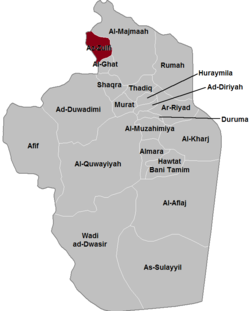User talk:Zulfi Farsath/sandbox
26°17′N 44°48′E / 26.283°N 44.800°E
Al Zulfi
محافظة الزلفي | |
|---|---|
 | |
 Location of Al Zulfi | |
| Coordinates: 26°17′N 44°48′E / 26.283°N 44.800°E | |
| Country | |
| Province | Riyadh Province |
| Government | |
| • Mayor | Zayd ibn Muhammad al-Hussein al-Tamimi |
| • Governor of the Governorate | Prince Salman Bin Abdul Aziz |
| Population (2020) | |
| • Total | 125.000 |
| • Density | 199.4/km2 (516/sq mi) |
| Sainthamaruth Authority estimate | |
| Time zone | UTC+3 (EAT) |
| • Summer (DST) | UTC+3 (EAT) |
| Postal Code | (5 digits) |
| Area code | +94-6 |
| Website | [1] |
Az Zulfi (also Zulfi, Zulfy City or Al Zulfi or Az Zilfi) is a city in Riyadh Province in central Saudi Arabia, about 260 kilometres northwest of Riyadh.[1] It is connected by Roads 418 and 535 which both link with the main Highway 65[2] which connects Riyadh to Buraidah which is about 101 kilometres by road to west of Al Zulfi. Zulfi also forms a governorate of Riyadh Province. The Al-Yamama/Tuwaiq mountain range begins in the desert to the north of Al Zulfi.[3]
Location
[edit]Az Zulfi is in the East of Al-Qassim Province and at the heart of the historical region of Najd. It is located roughly 70kilometers from Buraydah (the capital of the province) and more than 290 kilometers north of the Saudi capital, Riyadh.
History
[edit]Early history
[edit]Although the location is sometimes identified with an ancient settlement mentioned by Yaqut and Al-Hamadani known as "oryarh",the history of zulfi proper dates back to the 3th[clarification needed] century. According to the chroniclers of Nejd.
During the Pre-Islamic era the settlement at the site was called zulifit or alkrm (Arabic: الزلفات و الكَرَمُ), and was reportedly founded by the tribe of Banu Hanifa & Banu tmym.[4] Hajr served as the capital of the province of Al Yamamah, whose governors were responsible for most of central and eastern Arabia during the Umayyad and Abbasid eras. Al-Yamamah broke away from the Abbasid Empire in 866 and the area fell under the rule of the Ukhaydhirites, who moved the capital from Hajr to nearby Al Kharj. The city then went into a long period of decline. In the 14th century, North African traveller Ibn Battuta wrote of his visit to Hajr, describing it as "the main city of Al-Yamamah, and its name is Hajr". Ibn Battuta goes on to describe it as a city of canals and trees with most of its inhabitants belonging to Bani Hanifa, and reports that he continued on with their leader to Mecca to perform the Hajj.
Later on, Hajr broke up into several separate settlements and estates. The most notable of these were Migrin (or Muqrin) and Mi'kal, though the name Hajr continued to appear in local folk poetry. The earliest known reference to the area by the name Riyadh comes from a 17th-century chronicler reporting on an event from the year 1590. In 1737, Deham ibn Dawwas, a refugee from neighboring Manfuha, took control of Riyadh. Ibn Dawwas built a single wall to encircle the various quarters of Riyadh, making them effectively a single town.
- ^ Al Zulfi. Saudi Arabian Television Channel 2. Retrieved 1 October 2011.
- ^ Orr, Michael J. (16 September 2010). An Unholy Alliance. iUniverse. p. 78. ISBN 978-1-4502-5403-8. Retrieved 1 October 2011.
- ^ Dindān; P. M. Kurpershoek (1994). Oral Poetry and Narratives from Central Arabia: The poetry of ad-Dindān. BRILL. p. 363. ISBN 978-90-04-09894-7. Retrieved 1 October 2011.
- ^ History of Riyadh Archived 2008-05-31 at the Wayback Machine at www.arriyadh.com

